Radial tunnel syndrome is a nerve compression condition that occurs when the posterior interosseous nerve (a branch of the radial nerve) is squeezed or compressed by the surrounding muscles in the outer (lateral) part of the forearm. This compression, located just below the elbow, is typically associated with repetitive arm movements (e.g., turning a screwdriver, lifting weights, and desk-based jobs).

This condition is nerve-related, which makes it different from tennis elbow (lateral epicondylitis, an inflammation of the tendons), a condition it is frequently confused with. Unfortunately, these patients are very often misdiagnosed with tennis elbow. In radial tunnel syndrome, the pain is a deeper, dull ache, usually localized to the outer (lateral) part of the upper-to-mid forearm. Numbness in the hand is rare; the primary issues are a reduction in muscle strength and a sensation of painful exertion.
In the initial phase, treatment involves activity modification, wrist splints, and anti-inflammatory medications (like ibuprofen). For symptoms that last longer than 3 months and disrupt the patient’s quality of life, surgical treatment becomes an option.

Surgery Duration: 30–45 minutes
Type of Anesthesia: Nerve block (an injection to numb the entire arm, also known as a brachial plexus block) or general anesthesia
Surgical Method: Releasing the pressure points where the radial nerve is trapped by muscles (this procedure is called a radial tunnel decompression)
First day: 2–4
First week: 2–3
After 2 weeks: 0–1
Discharge on the same day
First 2 weeks: Resting the elbow, bandage and suture (stitch) care
After 2 weeks: Light hand and arm exercises
4–6 weeks: Return to pain-free activities
8. weeks: Return to sports and heavy work is possible
First dressing change: Day 2
Wound check: 1st week
Suture (stitch) removal: Day 10
No. Tennis elbow is a disorder of the tendon (the tissue connecting muscle to bone), whereas radial tunnel syndrome is a nerve compression. The location of the pain and the treatment methods are different.
The posterior interosseous nerve primarily controls muscles, not skin sensation. Therefore, weakness and pain are the dominant symptoms, rather than numbness.
Yes, with proper patient selection and the correct surgical technique, the success rate is high. However, the healing process may take several months.
In moderate-to-advanced cases, physical therapy may be necessary after surgery to ensure a full recovery.
Although rare, recurrence is possible. It is important to pay attention to wrist and elbow ergonomics (how you position your arm and wrist during daily activities).